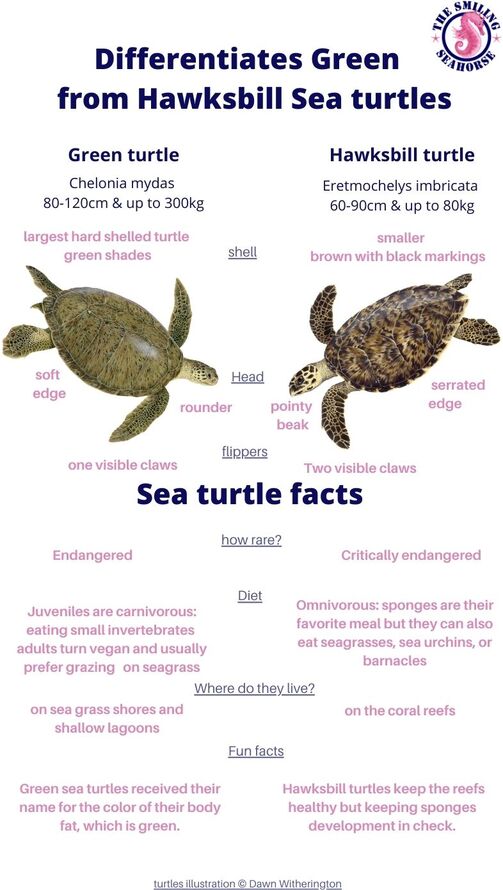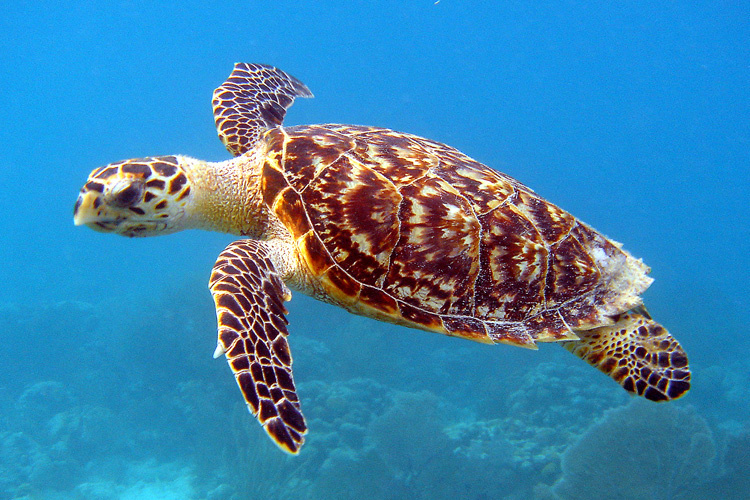Hawksbill Sea Turtle Fun Facts
Get ready to dive into the fascinating world of hawksbill sea turtles and discover some incredible fun facts about these magnificent creatures! From their unique physical features to their important role in marine ecosystems, hawksbill sea turtles are a true marvel of the ocean. So, grab your snorkel and let’s explore!
When it comes to physical appearance, hawksbill sea turtles are easily recognizable with their beautiful and intricate shells. These shells, also known as carapaces, are made up of overlapping scales that resemble the pattern of a hawksbill. Hence, their name! But these turtles are not just stylish; they also boast a keen sense of smell, which helps them locate their favorite food: sponges. Yes, you heard that right! Hawksbill sea turtles have a unique diet that consists mainly of sponges, which makes them a vital part of coral reef ecosystems.
Now, let’s talk about their remarkable nesting habits. Hawksbill sea turtles are known for their epic journeys to lay their eggs on sandy beaches. They can travel hundreds or even thousands of kilometers to return to the same beach where they were born. Talk about loyalty! Once they find the perfect spot, they dig a deep hole in the sand and lay around 100 to 150 eggs. After carefully covering the nest, the mother turtle returns to the ocean, leaving the eggs to hatch on their own. It’s a true testament to the circle of life and the resilience of these incredible creatures.
So, get ready to be amazed by these hawksbill sea turtle fun facts as we dive deeper into their underwater world. From their stunning shells to their extraordinary nesting habits, these turtles are truly a marvel to behold. Stay tuned for more fascinating information about these graceful ocean dwellers!

Hawksbill Sea Turtle Fun Facts: Discover the Fascinating World of These Graceful Creatures
The hawksbill sea turtle, with its strikingly beautiful shell and graceful movements, is a captivating creature that has captured the hearts of many. Found in tropical and subtropical waters around the world, these turtles are known for their unique features and intriguing behaviors. In this article, we will delve into the world of hawksbill sea turtles and explore some fascinating fun facts about these incredible creatures.
The Hawksbill’s Exquisite Shell: A Work of Art
The hawksbill sea turtle is renowned for its stunning shell, which is one of the main reasons why it has been hunted to near extinction. The shell, also known as the carapace, is made up of overlapping scales called scutes. These scutes have a distinctive pattern that resembles the scales of a hawk, hence the name “hawksbill.” The colors of the shell range from amber to dark brown, with intricate patterns that vary from turtle to turtle.
The shell of the hawksbill sea turtle is highly sought after for its beauty and durability. It is often used in the production of jewelry, accessories, and even furniture. However, the harvesting of hawksbill turtles for their shells has had a devastating impact on their population, making them critically endangered.
The Hawksbill Diet: A Master of Marine Cuisine
Hawksbill sea turtles are primarily carnivorous, with a diet that consists mainly of sponges. They have a specialized beak-like mouth that allows them to reach into crevices and feed on the sponges that other marine creatures cannot access. This unique feeding behavior helps maintain the health of coral reefs by preventing sponges from overgrowing and smothering the coral.
In addition to sponges, hawksbill turtles also consume other marine invertebrates such as jellyfish, sea anemones, and squid. They play a crucial role in maintaining the balance of the marine ecosystem by controlling the populations of these organisms. Furthermore, their feeding habits contribute to the health and diversity of coral reefs, which are vital habitats for numerous marine species.
Migration and Nesting: An Incredible Journey
Hawksbill sea turtles are known for their impressive migratory patterns. These turtles can travel hundreds or even thousands of miles between their feeding grounds and nesting beaches. They have an uncanny ability to navigate using Earth’s magnetic field, allowing them to return to the same nesting site year after year.
When it comes time to lay their eggs, female hawksbill turtles return to the beaches where they were born. They dig deep nests in the sand using their flippers and lay around 100 to 150 eggs at a time. The temperature of the sand determines the sex of the hatchlings, with warmer temperatures producing females and cooler temperatures producing males.
Conservation Efforts: Protecting a Precious Species
Due to their critically endangered status, hawksbill sea turtles are the focus of numerous conservation efforts around the world. These initiatives aim to protect their nesting beaches, reduce threats such as poaching and habitat destruction, and raise awareness about the importance of preserving these magnificent creatures.
One key aspect of conservation is the establishment of marine protected areas where hawksbill turtles and other marine species can thrive without human interference. These protected areas provide a safe haven for the turtles to nest, feed, and migrate. Additionally, efforts are being made to educate local communities about the importance of sustainable fishing practices and the preservation of critical habitats.
The Role of Hawksbill Turtles in the Ecosystem: A Delicate Balance
Hawksbill sea turtles play a crucial role in maintaining the health and balance of marine ecosystems. As they feed on sponges, they prevent these organisms from overgrowing and damaging coral reefs. The vibrant and diverse coral reefs are not only a visual spectacle but also provide habitats for countless marine species. By protecting hawksbill turtles, we are also safeguarding the delicate balance of these ecosystems.
Furthermore, the hawksbill’s migration patterns contribute to the dispersal of nutrients and the distribution of other marine organisms. Their movement between different habitats helps maintain the biodiversity and connectivity of marine ecosystems. Without these turtles, the health and resilience of our oceans would be compromised.
Threats to Hawksbill Sea Turtles: A Battle for Survival
Despite their importance and beauty, hawksbill sea turtles face numerous threats that endanger their survival. Habitat destruction, pollution, entanglement in fishing gear, and climate change all pose significant risks to their population. Additionally, illegal hunting for their shells remains a major threat, as the demand for hawksbill products persists in some regions.
It is crucial that we continue to raise awareness about the plight of hawksbill sea turtles and take action to protect them. By supporting conservation initiatives, advocating for sustainable practices, and educating others, we can contribute to the preservation of these magnificent creatures and ensure their survival for generations to come.
The Importance of Protecting Hawksbill Sea Turtles
In conclusion, hawksbill sea turtles are truly remarkable creatures that deserve our admiration and protection. Their unique shell, specialized diet, impressive migratory patterns, and crucial role in marine ecosystems make them invaluable to our planet. By understanding their significance and working together to conserve their habitats, we can help ensure that future generations will continue to be captivated by the beauty and wonder of hawksbill sea turtles. Let us join forces in the fight to protect these magnificent creatures and secure a brighter future for them and our oceans.
Key Takeaways: Hawksbill Sea Turtle Fun Facts
- Hawksbill sea turtles are known for their beautiful and colorful shells.
- They are found in tropical and subtropical waters around the world.
- These turtles are excellent swimmers and can reach speeds of up to 20 miles per hour.
- Hawksbill sea turtles are omnivores, eating both plants and animals.
- They play a crucial role in maintaining the health of coral reefs by feeding on sponges.
Frequently Asked Questions
What are some interesting facts about hawksbill sea turtles?
The hawksbill sea turtle, scientifically known as Eretmochelys imbricata, is a fascinating marine creature with several interesting facts associated with it. These facts include:
1. Unique Shell: Hawksbill sea turtles have a beautiful shell that is known for its unique pattern of overlapping scutes. The shell is made of a combination of bones and keratin, giving it a tough yet flexible structure.
2. Specialized Feeding: These turtles are known for their diet consisting mainly of sponges. They have a specialized beak-like mouth that helps them reach into crevices and feed on sponges, which many other sea turtles cannot do.
How long do hawksbill sea turtles live?
Hawksbill sea turtles have a relatively long lifespan compared to many other marine species. On average, these turtles can live up to 50 years in the wild. However, there have been reports of hawksbill sea turtles living for over 100 years in exceptional cases.
Their longevity is influenced by various factors such as habitat quality, availability of food, and protection from predators. Conservation efforts play a crucial role in ensuring the survival and longevity of these magnificent creatures.
Where can hawksbill sea turtles be found?
Hawksbill sea turtles can be found in various parts of the world, inhabiting tropical and subtropical oceans. They are known to frequent coral reefs, rocky coastlines, and shallow coastal waters. Some specific regions where hawksbill sea turtles can be found include:
1. Caribbean Sea: The Caribbean Sea is home to a significant population of hawksbill sea turtles. The warm waters and abundant coral reefs provide an ideal habitat for these turtles.
2. Great Barrier Reef: The Great Barrier Reef in Australia is another important location where hawksbill sea turtles can be found. The diverse marine ecosystem of the reef supports a thriving population of these turtles.
How do hawksbill sea turtles contribute to the ecosystem?
Hawksbill sea turtles play a crucial role in maintaining the health and balance of marine ecosystems. Some ways in which they contribute to the ecosystem include:
1. Coral Reef Health: These turtles feed on sponges, which helps control their population. Overgrowth of sponges can be detrimental to coral reefs, so the presence of hawksbill sea turtles helps maintain a healthy balance.
2. Seed Dispersal: Hawksbill sea turtles consume various types of marine vegetation, including seagrasses. They then excrete the seeds of these plants in different locations, aiding in seed dispersal and the growth of seagrass meadows.
Why are hawksbill sea turtles considered endangered?
Hawksbill sea turtles are considered endangered due to various threats they face in their natural habitats. Some of the major reasons for their endangered status include:
1. Habitat Loss: Destruction of coral reefs and nesting beaches due to coastal development and pollution reduces suitable habitats for hawksbill sea turtles.
2. Illegal Trade: The hawksbill’s beautiful shell is highly prized in the illegal trade market, leading to excessive hunting and poaching of these turtles for their shells.
Efforts are being made worldwide to protect and conserve hawksbill sea turtles, including implementing strict regulations on trade and establishing protected areas for nesting and feeding grounds.

Final Summary: Dive into the Fascinating World of Hawksbill Sea Turtles!
And there you have it, folks, a delightful journey through the captivating world of hawksbill sea turtles! These enchanting creatures never fail to amaze with their unique characteristics and incredible adaptations. From their beautiful shells to their important role in preserving marine ecosystems, hawksbill sea turtles are truly a marvel of nature.
Throughout this article, we’ve uncovered some fascinating fun facts about hawksbill sea turtles. We’ve learned about their impressive navigation skills, their diet consisting mainly of sponges, and their vital contribution to coral reef health. We’ve also explored the threats they face, such as habitat loss and poaching, and the conservation efforts in place to protect these magnificent creatures.
So, the next time you find yourself near a tropical coastline or diving in crystal-clear waters, keep an eye out for the graceful hawksbill sea turtle. Remember, they are not just creatures of wonder, but also ambassadors of our oceans. Let’s continue to spread awareness and support initiatives that ensure their survival for generations to come.

